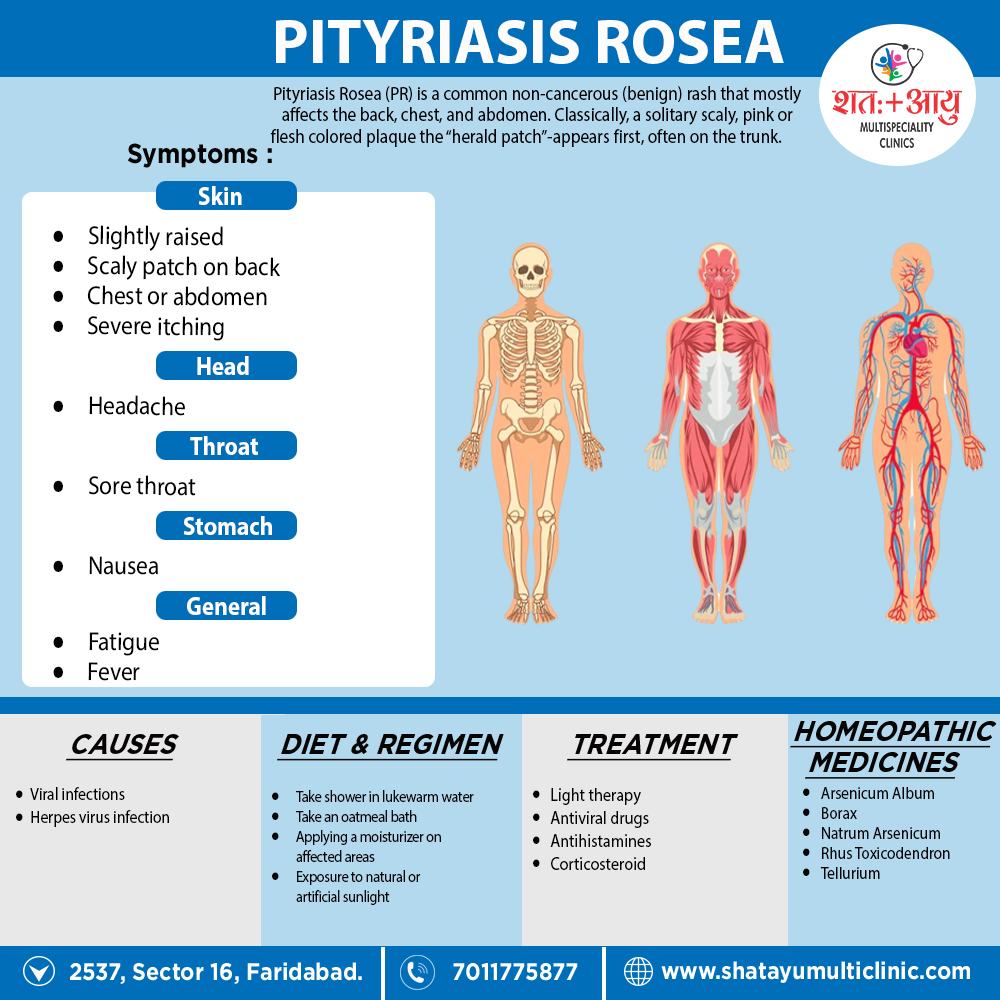Pityriasis rosea (PR):
It is a common and typically self-limited cutaneous eruption. Classically, a solitary scaly, pink or flesh colored plaque the “herald patch” – appears first, often on the trunk.
The ensuing eruption appears days to weeks later and consists of multiple discrete oval, erythematous, and scaly plaques and patches oriented along skin cleavage lines, most commonly on the trunk and upper extremities.
The face, palms, and soles are usually spare.
Who’s at risk?
Pityriasis rosea can occur in people of any age, any race, and either sex, but it is most common in teenagers and young adults (10–40 years old).
The most common locations for pityriasis rosea include:
- Chest
- Upper back
- Neck
- Abdomen
- Upper arms
- Thighs
In an uncommon type of pityriasis rosea, the rash may be concentrated in the armpits and groin or on the face, forearms, and shins.
Pityriasis rosea usually begins with a single patch of pink-to-red, scaly skin, from 2–5 cm in size.
herald patch
This “herald patch” is usually locate on the trunk, neck, or upper arms. The herald patch is follow 1–3 weeks later by the development of a widespread rash, with smaller (0.5–2 cm) oval patches of pink-to-red, scaly skin on the trunk and upper arms.
Christmas tree
The second rash forms a “Christmas tree” pattern on the back.
Some people report feeling mildly ill (headache, stuffy nose, muscle aches) for 1–2 weeks before the herald patch forms.
Additionally, some people experience itching with pityriasis rosea. Becoming overheat by exercising or taking a hot shower may increase itching or make the rash more obvious.
Pityriasis rosea is a self-limited condition, meaning that it goes away on its own, typically within 6–8 weeks, without treatment.
However, the rash often leaves behind patches of lighter (hypopigmented) or darker (hyperpigmented) skin, which are more obvious in darker-skinned people and may take months to return to its normal color.
Although most people have the classic form of pityriasis rosea, some individuals develop a form of pityriasis rosea with unusual (atypical) features. These atypical types of pityriasis rosea may be more difficult to diagnose and may require a skin biopsy.
This procedure involves:
- Numbing the skin with an injectable anesthetic.
- Sampling a small piece of skin by using a flexible razor blade, a scalpel, or a tiny cookie cutter (called a “punch biopsy”). If a punch biopsy is taken, a stitch (suture) or two may be placed and will need to be removed 6–14 days later.
- Having the skin sample examined under the microscope by a specially trained physician (dermatopathologist).
In addition, your physician may want to do blood tests for other medical conditions.
Because pityriasis rosea is benign and self-limited, no treatment required. However, some people with pityriasis rosea have mild-to-severe itching, and your physician may suggest:
- Moisturizing creams or lotions
- Oatmeal baths
- Topical menthol-phenol lotions
- Topical corticosteroid (cortisone) creams or lotions
- Oral anti-histamine pills
- Ultraviolet light treatments
- Oral corticosteroid pills (if the pityriasis rosea is very severe)

